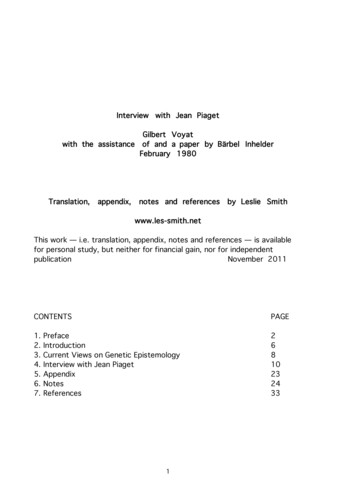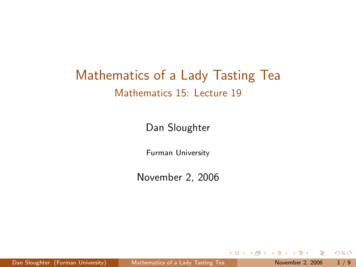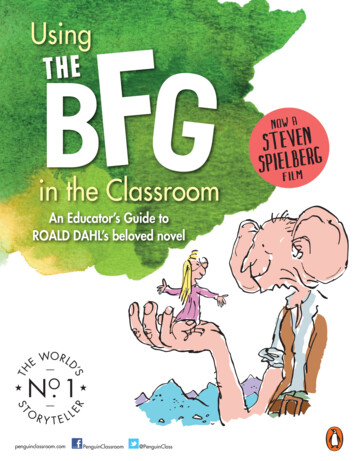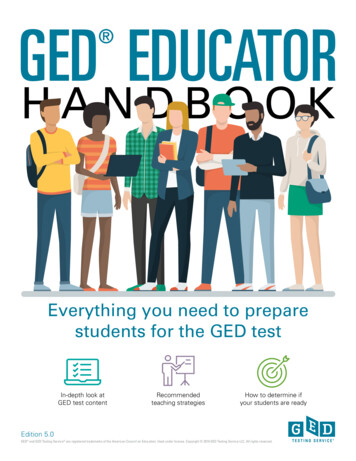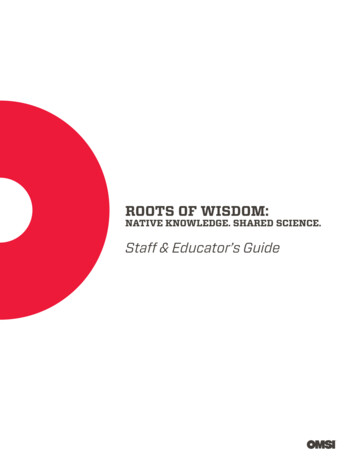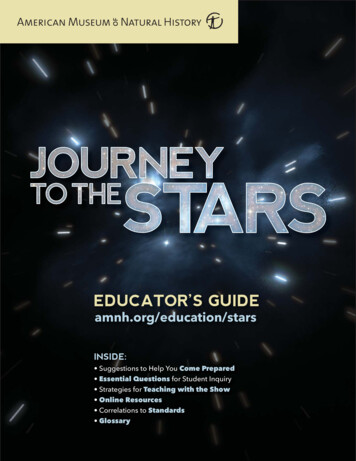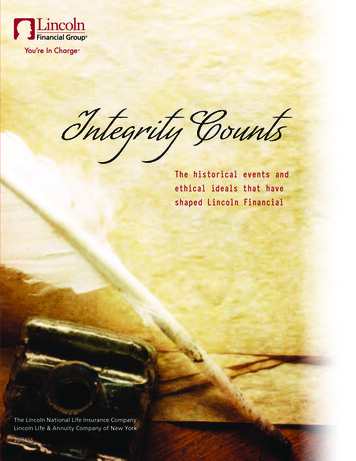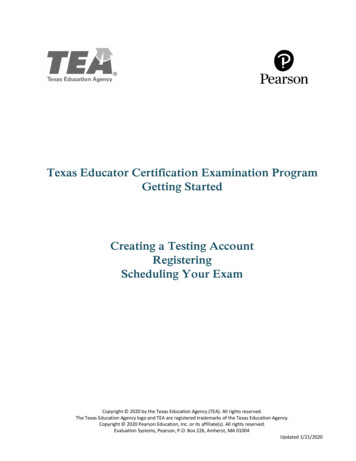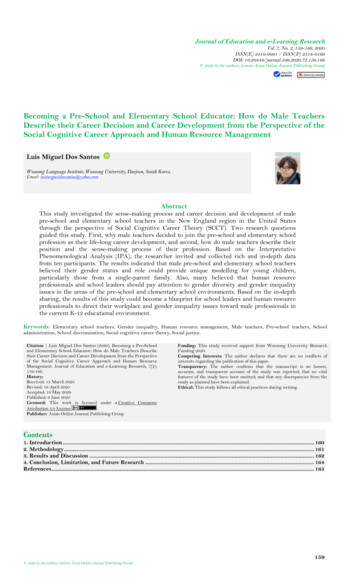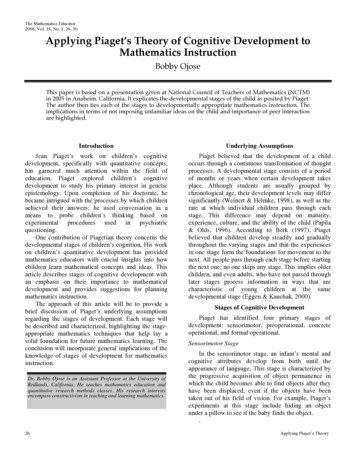
Transcription
The Mathematics Educator2008, Vol. 18, No. 1, 26–30Applying Piaget’s Theory of Cognitive Development toMathematics InstructionBobby OjoseThis paper is based on a presentation given at National Council of Teachers of Mathematics (NCTM)in 2005 in Anaheim, California. It explicates the developmental stages of the child as posited by Piaget.The author then ties each of the stages to developmentally appropriate mathematics instruction. Theimplications in terms of not imposing unfamiliar ideas on the child and importance of peer interactionare highlighted.IntroductionUnderlying AssumptionsJean Piaget’s work on children’s cognitivedevelopment, specifically with quantitative concepts,has garnered much attention within the field ofeducation. Piaget explored children’s cognitivedevelopment to study his primary interest in geneticepistemology. Upon completion of his doctorate, hebecame intrigued with the processes by which childrenachieved their answers; he used conversation as ameans to probe children’s thinking based onexperimental procedures used in psychiatricquestioning.One contribution of Piagetian theory concerns thedevelopmental stages of children’s cognition. His workon children’s quantitative development has providedmathematics educators with crucial insights into howchildren learn mathematical concepts and ideas. Thisarticle describes stages of cognitive development withan emphasis on their importance to mathematicaldevelopment and provides suggestions for planningmathematics instruction.The approach of this article will be to provide abrief discussion of Piaget’s underlying assumptionsregarding the stages of development. Each stage willbe described and characterized, highlighting the stageappropriate mathematics techniques that help lay asolid foundation for future mathematics learning. Theconclusion will incorporate general implications of theknowledge of stages of development for mathematicsinstruction.Piaget believed that the development of a childoccurs through a continuous transformation of thoughtprocesses. A developmental stage consists of a periodof months or years when certain development takesplace. Although students are usually grouped bychronological age, their development levels may differsignificantly (Weinert & Helmke, 1998), as well as therate at which individual children pass through eachstage. This difference may depend on maturity,experience, culture, and the ability of the child (Papila& Olds, 1996). According to Berk (1997), Piagetbelieved that children develop steadily and graduallythroughout the varying stages and that the experiencesin one stage form the foundations for movement to thenext. All people pass through each stage before startingthe next one; no one skips any stage. This implies olderchildren, and even adults, who have not passed throughlater stages process information in ways that arecharacteristic of young children at the samedevelopmental stage (Eggen & Kauchak, 2000).Dr. Bobby Ojose is an Assistant Professor at the University ofRedlands, California. He teaches mathematics education andquantitative research methods classes. His research interestsencompass constructivism in teaching and learning mathematics.26Stages of Cognitive DevelopmentPiaget has identified four primary stages ofdevelopment: sensorimotor, preoperational, concreteoperational, and formal operational.Sensorimotor StageIn the sensorimotor stage, an infant’s mental andcognitive attributes develop from birth until theappearance of language. This stage is characterized bythe progressive acquisition of object permanence inwhich the child becomes able to find objects after theyhave been displaced, even if the objects have beentaken out of his field of vision. For example, Piaget’sexperiments at this stage include hiding an objectunder a pillow to see if the baby finds the object.Applying Piaget’s Theory
An additional characteristic of children at thisstage is their ability to link numbers to objects (Piaget,1977) (e.g., one dog, two cats, three pigs, four hippos).To develop the mathematical capability of a child inthis stage, the child’s ability might be enhanced if he isallowed ample opportunity to act on the environmentin unrestricted (but safe) ways in order to start buildingconcepts (Martin, 2000). Evidence suggests thatchildren at the sensorimotor stage have someunderstanding of the concepts of numbers and counting(Fuson, 1988). Educators of children in this stage ofdevelopment should lay a solid mathematicalfoundation by providing activities that incorporatecounting and thus enhance children’s conceptualdevelopment of number. For example, teachers andparents can help children count their fingers, toys, andcandies. Questions such as “Who has more?” or “Arethere enough?” could be a part of the daily lives ofchildren as young as two or three years of age.Another activity that could enhance themathematical development of children at this stageconnects mathematics and literature. There is aplethora of children’s books that embed mathematicalcontent. (See Appendix A for a non-exhaustive list ofchildren’s books incorporating mathematical conceptsand ideas.) A recommendation would be that thesebooks include pictorial illustrations. Because childrenat this stage can link numbers to objects, learners canbenefit from seeing pictures of objects and theirrespective numbers simultaneously. Along with themathematical benefits, children’s books can contributeto the development of their reading skills andcomprehension.Preoperational StageThe characteristics of this stage include an increasein language ability (with over-generalizations),symbolic thought, egocentric perspective, and limitedlogic. In this second stage, children should engage withproblem-solving tasks that incorporate availablematerials such as blocks, sand, and water. While thechild is working with a problem, the teacher shouldelicit conversation from the child. The verbalization ofthe child, as well as his actions on the materials, givesa basis that permits the teacher to infer the mechanismsof the child’s thought processes.There is lack of logic associated with this stage ofdevelopment; rational thought makes little appearance.The child links together unrelated events, sees objectsas possessing life, does not understand point-of-view,and cannot reverse operations. For example, a child atthis stage who understands that adding four to fiveBobby Ojoseyields nine cannot yet perform the reverse operation oftaking four from nine.Children’s perceptions in this stage of developmentare generally restricted to one aspect or dimension ofan object at the expense of the other aspects. Forexample, Piaget tested the concept of conservation bypouring the same amount of liquid into two similarcontainers. When the liquid from one container ispoured into a third, wider container, the level is lowerand the child thinks there is less liquid in the thirdcontainer. Thus the child is using one dimension,height, as the basis for his judgment of anotherdimension, volume.Teaching students in this stage of aracterizing objects. For example, when studentsinvestigate geometric shapes, a teacher could askstudents to group the shapes according to similarcharacteristics. Questions following the investigationcould include, “How did you decide where each objectbelonged? Are there other ways to group thesetogether?” Engaging in discussion or interactions withthe children may engender the children’s discovery ofthe variety of ways to group objects, thus helping thechildren think about the quantities in novel ways(Thompson, 1990).Concrete Operations StageThe third stage is characterized by remarkablecognitive growth, when children’s development oflanguage and acquisition of basic skills acceleratedramatically. Children at this stage utilize their sensesin order to know; they can now consider two or threedimensions simultaneously instead of successively. Forexample, in the liquids experiment, if the child noticesthe lowered level of the liquid, he also notices the dishis wider, seeing both dimensions at the same time.Additionally, seriation and classification are the twological operations that develop during this stage(Piaget, 1977) and both are essential for understandingnumber concepts. Seriation is the ability to orderobjects according to increasing or decreasing length,weight, or volume. On the other hand, classificationinvolves grouping objects on the basis of a commoncharacteristic.According to Burns & Silbey (2000), “hands-onexperiences and multiple ways of representing amathematical solution can be ways of fostering thedevelopment of this cognitive stage” (p. 55). Theimportance of hands-on activities cannot beoveremphasized at this stage. These activities providestudents an avenue to make abstract ideas concrete,27
allowing them to get their hands on mathematical ideasand concepts as useful tools for solving problems.Because concrete experiences are needed, teachersmight use manipulatives with their students to exploreconcepts such as place value and arithmeticaloperations. Existing manipulative materials include:pattern blocks, Cuisenaire rods, algebra tiles, algebracubes, geoboards, tangrams, counters, dice, andspinners. However, teachers are not limited tocommercial materials, they can also use convenientmaterials in activities such as paper folding andcutting. As students use the materials, they acquireexperiences that help lay the foundation for moreadvanced mathematical thinking. Furthermore,students’ use of materials helps to build theirmathematical confidence by giving them a way to testand confirm their reasoning.One of the important challenges in mathematicsteaching is to help students make connections betweenthe mathematics concepts and the activity. Childrenmay not automatically make connections between thework they do with manipulative materials and thecorresponding abstract mathematics: “children tend tothink that the manipulations they do with models areone method for finding a solution and pencil-and-papermath is entirely separate” (Burns & Silbey, 2000, p.60). For example, it may be difficult for children toconceptualize how a four by six inch rectangle builtwith wooden tiles relates to four multiplied by six, orfour groups of six. Teachers could help students makeconnections by showing how the rectangles can beseparated into four rows of six tiles each and bydemonstrating how the rectangle is anotherrepresentation of four groups of six.Providing various mathematical representationsacknowledges the uniqueness of students and providesmultiple paths for making ideas meaningful.Engendering opportunities for students to presentmathematical solutions in multiple ways (e.g.,symbols, graphs, tables, and words) is one tool forcognitive development in this stage. Eggen & Kauchak(2000) noted that while a specific way of representingan idea is meaningful to some students, a differentrepresentation might be more meaningful to others.Formal Operations StageThe child at this stage is capable of forminghypotheses and deducing possible consequences,allowing the child to construct his own mathematics.Furthermore, the child typically begins to developabstract thought patterns where reasoning is executedusing pure symbols without the necessity of perceptive28data. For example, the formal operational learner cansolve x 2x 9 without having to refer to a concretesituation presented by the teacher, such as, “Tony ate acertain number of candies. His sister ate twice as many.Together they ate nine. How many did Tony eat?”Reasoning skills within this stage refer to the mentalprocess involved in the generalizing and evaluating oflogical arguments (Anderson, 1990) and includeclarification, inference, evaluation, and application.Clarification. Clarification requires students toidentify and analyze elements of a problem, allowingthem to decipher the information needed in solving aproblem. By encouraging students to extract relevantinformation from a problem statement, teachers ng.Inference.Studentsatthisstagearedevelopmentally ready to make inductive anddeductive inferences in mathematics. Deductiveinferences involve reasoning from general concepts tospecific instances. On the other hand, inductiveinferences are based on extracting similarities anddifferences among specific objects and events andarriving at generalizations.Evaluation. Evaluation involves using criteria tojudge the adequacy of a problem solution. Forexample, the student can follow a predetermined rubricto judge the correctness of his solution to a problem.Evaluation leads to formulating hypotheses aboutfuture events, assuming one’s problem solving iscorrect thus far.Application. Application involves studentsconnecting mathematical concepts to real-lifesituations. For example, the student could apply hisknowledge of rational equations to the followingsituation: “You can clean your house in 4 hours. Yoursister can clean it in 6 hours. How long will it take youto clean the house, working together?”Implications of Piaget’s TheoryCritics of Piaget’s work argue that his proposedtheory does not offer a complete description ofcognitive development (Eggen & Kauchak, 2000). Forexample, Piaget is criticized for underestimating theabilities of young children. Abstract directions andrequirements may cause young children to fail at tasksthey can do under simpler conditions (Gelman, Meck,& Merkin, 1986). Piaget has also been criticized foroverestimating the abilities of older learners, havingimplications for both learners and teachers. Forexample, middle school teachers interpreting Piaget’swork may assume that their students can always thinkApplying Piaget’s Theory
logically in the abstract, yet this is often not the case(Eggen & Kauchak, 2000).Although not possible to teach cognitivedevelopment explicitly, research has demonstrated thatit can be accelerated (Zimmerman & Whitehurst,1979). Piaget believed that the amount of time eachchild spends in each stage varies by environment(Kamii, 1982). All students in a class are notnecessarily operating at the same level. Teachers couldbenefit from understanding the levels at which theirstudents are functioning and should try to ascertaintheir students’ cognitive levels to adjust their teachingaccordingly. By emphasizing methods of reasoning,the teacher provides critical direction so that the childcan discover concepts through investigation. The childshould be encouraged to self-check, approximate,reflect and reason while the teacher studies the child’swork to better understand his thinking (Piaget, 1970).The numbers and quantities used to teach thechildren number should be meaningful to them.Various situations can be set up that encouragemathematical reasoning. For example, a child may beasked to bring enough cups for everybody in the class,without being explicitly told to count. This will requirethem to compare the number of people to the numberof cups needed. Other examples include dividingobjects among a group fairly, keeping classroomrecords like attendance, and voting to make classdecisions.Games are also a good way to acquireunderstanding of mathematical principles (Kamii,1982). For example, the game of musical chairsrequires coordination between the set of children andthe set of chairs. Scorekeeping in marbles and bowlingrequires comparison of quantities and simplearithmetical operations. Comparisons of quantities arerequired in a guessing game where one child chooses anumber between one and ten and another attempts todetermine it, being told if his guesses are too high ortoo low.SummaryAs children develop, they progress through stagescharacterized by unique ways of understanding theworld. During the sensorimotor stage, young childrendevelop eye-hand coordination schemes and objectpermanence. The preoperational stage includes growthof symbolic thought, as evidenced by the increased useof language. During the concrete operational stage,children can perform basic operations such asclassification and serial ordering of concrete objects. Inthe final stage, formal operations, students develop theBobby Ojoseability to think abstractly and metacognitively, as wellas reason hypothetically. This article articulated thesestages in light of mathematics instruction. In general,the knowledge of Piaget’s stages helps the teacherunderstand the cognitive development of the child asthe teacher plans stage-appropriate activities to keepstudents active.ReferencesAnderson, J. R. (1990). Cognitive psychology and its implications(3rd ed.). New York: Freeman.Berk, L. E. (1997). Child development (4th ed.). Needham Heights,MA: Allyn & Bacon.Burns, M., & Silbey, R. (2000). So you have to teach math? Soundadvice for K-6 teachers. Sausalito, CA: Math SolutionsPublications.Eggen, P. D., & Kauchak, D. P. (2000). Educational psychology:Windows on classrooms (5th ed.). Upper Saddle River, NJ:Prentice Hall.Fuson, K. C. (1988). Children’s counting and concepts of numbers.New York: Springer.Gelman, R., Meck, E., & Merkin, S. (1986). Young children’snumerical competence. Cognitive Development, 1, 1–29.Johnson-Laird, P. N. (1999). Deductive reasoning. Annual Reviewof Psychology, 50, 109–135.Kamii, C. (1982). Number in preschool and kindergarten:Educational implications of Piaget’s theory. Washington, DC:National Association for the Education of Young Children.Martin, D. J. (2000). Elementary science methods: A constructivistapproach (2nd ed.). Belmont, CA: Wadsworth.Papila, D. E., & Olds, S. W. (1996). A child’s world: Infancythrough adolescence (7th ed.). New York: McGraw-Hill.Piaget, J. (1970). Science of education and the psychology of thechild. New York: Viking.Piaget, J. (1977). Epistemology and psychology of functions.Dordrecht, Netherlands: D. Reidel Publishing Company.Thompson, C. S. (1990). Place value and larger numbers. In J. N.Payne (Ed.), Mathematics for young children (pp. 89–108).Reston, VA: National Council of Teachers of Mathematics.Thurstone, L. L. (1970). Attitudes can be measured. In G. F.Summers (Ed.), Attitude measurement (pp. 127–141).Chicago: Rand McNallyWeinert, F. E., & Helmke, A. (1998). The neglected role ofindividual differences in theoretical models of cognitivedevelopment. Learning and Instruction, 8, 309–324.Wise, S. L. (1985). The development and validity of a scalemeasuring attitudes toward statistics. Educational andPsychological Measurement, 45, 401–405Zimmerman, B. J., & Whitehurst, G. J. (1979). Structure andfunction: A comparison of two views of the development oflanguage and cognition. In G. J. Whitehurst and B. J.Zimmerman (Eds.), The functions of language and cognition(pp. 1–22). New York: Academic Press.29
Appendix A: Children’s Literature Incorporating Mathematical Concepts and IdeasAnno, M. (1982). Anno’s counting house. New York: Philomel Books.Anno, M. (1994). Anno’s magic seeds. New York: Philomel Books.Anno, M., & Anno, M. (1983). Anno’s mysterious multiplying jar. New York: Philomel Books.Ash, R. (1996). Incredible comparisons. New York: Dorling Kindersley.Briggs, R. (1970). Jim and the beanstalk. New York: Coward–McCann.Carle, E. (1969). The very hungry caterpillar. New York: Putnam.Chalmers, M. (1986). Six dogs, twenty-three cats, forty-five mice, and one hundred sixty spiders. New York:Harper Collins.Chwast, S. (1993). The twelve circus rings. San Diego, CA: Gulliver Books, Harcourt Brace Jovanovich.Clement, R. (1991). Counting on Frank. Milwaukee: Gareth Stevens Children’s Book.Cushman, R. (1991). Do you wanna bet? Your chance to find out about probability. New York: Clarion Books.Dee, R. (1988). Two ways to count to ten. New York: Holt.Falwell, C. (1993). Feast for 10. New York: Clarion Books.Friedman, A. (1994). The king’s commissioners. New York: Scholastic.Gag, W. (1928). Millions of cats. New York: Coward-McCann.Giganti, P. (1988). How many snails? A counting book. New York: Greenwillow.Giganti, P. (1992). Each orange had 8 slices. New York: Greenwillow.Greenfield, E. (1989). Aaron and Gayla’s counting book. Boston: Houghton Mifflin.Hoban, T. (1981). More than one. New York: Greenwillow.Hutchins, P. (1986). The doorbell rang. New York: Greenwillow.Jaspersohn, W. (1993). Cookies. Old Tappan, NJ: Macmillan.Juster, N. (1961). The phantom tollbooth. New York: Random House.Linden, A. M. (1994). One sailing grandma: A Caribbean counting book. New York: Heinemann.Lobal, A. (1970). Frog and toad are friends. New York: Harper-Collins.Mathews, L. (1979). Gator pie. New York: Dodd, Mead.McKissack, P. C. (1992). A million fish more or less. New York: Knopf.Munsch, R. (1987). Moira’s birthday. Toronto: Annick Press.Myller, R. (1990). How big is a foot? New York: Dell.Norton, M. (1953). The borrowers. New York: Harcourt Brace.Parker, T. (1984). In one day. Boston: Houghton Mifflin.Pluckrose, H. (1988). Pattern. New York: Franklin Watts.San Souci, R. (1989). The boy and the ghost. New York: Simon-Schuster Books.St. John, G. (1975). How to count like a Martian. New York: Walck.Schwartz, D. (1985). How much is a million? New York: Lothrop, Lee, & Shepard.Sharmat, M. W. (1979). The 329th friend. New York: Four Winds Press.Tahan, M. (1993). The man who counted. A collection of mathematical adventures. New York: Norton.Wells, R. E. (1993). Is the blue whale the biggest thing there is? Morton Grove, IL: Whitman.Wolkstein, D. (1972). 8,000 stones. New York: Doubleday.30Applying Piaget’s Theory
with wooden tiles relates to four multiplied by six, or four groups of six. Teachers could help students make connections by showing how the rectangles can be separated into four rows of six tiles each and by demonstrating how the rectangle is another representation of four grou
